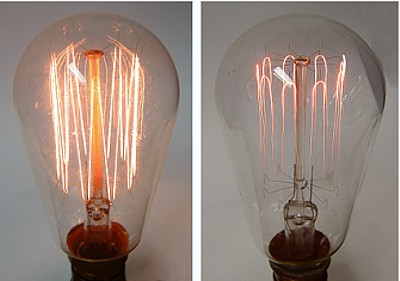|
|
|
|
|
The mains voltage tungsten lamp requires a relatively long filament of very small diameter. A typical modern 240V 100W GLS lamp contains a filament finer than a human hair and a staggering 1152mm in length. In the first tungsten lamps the great length of this filament was accommodated by mounting it in a series of V-form hairpins, strung between two sets of supports at either end of the bulb. This is known as the 'Squirrel Cage' or S-1 filament mount construction, and is illustrated in Figure I8 to the right. The bulb encloses high vacuum as the hot filament is chemically very reactive and would soon oxidise in the presence of air.
As already mentioned, filaments evaporate during their high temperature operation, and this results in the wire becoming thinner over time. Some parts of the filament always evaporate slightly faster than others, for instance due to microscopic defects in the tungsten wire which cannot be manufactured with a perfectly uniform diameter. These thinned regions lead to the formation of hot spots during operation. The higher temperature in the region of the hot spots accelerates the rate of evaporation, which proceeds until the wire either overheats and melts, or it becomes so thin that it can no longer support its own weight. In GLS lamp design it is customary to choose a filament temperature that will deliver an average lifetime of 1000 hours before failure. |
 Fig. I8 - Cage Filament
Fig. I8 - Cage Filament |
It is clearly desirable to find some method of retarding the rate of tungsten evaporation. This would allow lamps of much longer life to be manufactured, but the prospects of creating a more efficient lamp are even more interesting. If evaporation is slowed, it is possible to boost the filament temperature and bring life back down to the 1000 hour level. Hotter filaments generate light more efficiently, as explained on the previous page. Since lamps consume many times their own cost price in electric current over lifetime, high efficacy lamps make better financial sense to the customer than long life versions, in almost every case.
One practical solution is to replace the vacuum in the bulb with an inert gas. The physical pressure of the gas acting on the filament then reduces the tendency for tungsten atoms to boil away from its surface, by exactly the same mechanism as the boiling point of water is increased in a pressure cooker. Unfortunately there is a snag - although the gas is effective in slowing filament evaporation, it of course has a higher thermal conductivity than vacuum. As a result it carries some heat away from the filament due to conduction and convection effects. This is clearly demonstrated in a pair of special squirrel-cage tungsten lamps manufactured by the author at the works of Victory Lighting, London. Both have identical filaments but one is vacuum and the other has an argon/nitrogen gas filling at a pressure of approximately 700 torr. |
 Fig. I9 - Vacuum (left) vs Gas-Filled (right)
Fig. I9 - Vacuum (left) vs Gas-Filled (right) |
These are illustrated in Figure I9, the lamp on the left being vacuum and on the right gas-filled. The vacuum lamp lights up brightly whereas the gas-filled version glows only dimly, even though they are both of the same wattage. It's easy to prove that the filament is losing heat to the gas-filling because if the tops of the two bulbs are touched, the glass on the gas-filled one is very much hotter - despite the fact that its filament is visibly so much colder. This often confuses people, but the reason for the colder filament is that the gas is conducting heat away and transferring it to the bulb wall above. |
The effect of the gas convection currents is also superbly visualised, because only the upper portion of the filament lights up due to the fact that heat rises. If the lamp is inverted the hot gases move to the other end of the bulb, and the glowing part of the filament also moves. A shimmering effect may be observed due to turbulence currents as the gas flows around the stem.
It is well known that modern incandescent lamps are gas filled, so the problem of heat loss to the gas filling has clearly been solved. The mechanisms of preventing thermal losses to the gas filling are described in detail on the following page under the section "Filament Coiling Effects". |
|
|
|
|
|